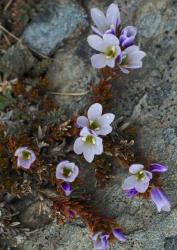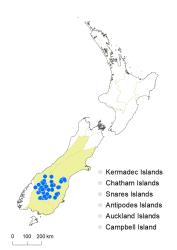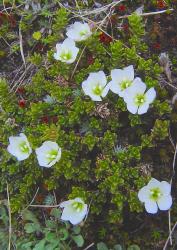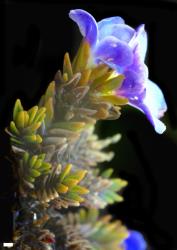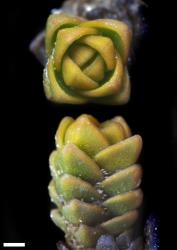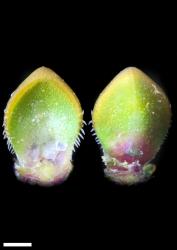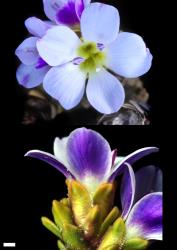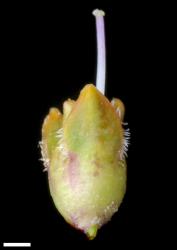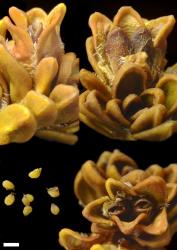- Taxon
- Gallery
- ≡ Paederota densifolia F.Muell., Trans. & Proc. Roy. Soc. Victoria 1: 107 (1855)
- ≡ Chionohebe densifolia (F.Muell.) B.G.Briggs & Ehrend., Contr. Herb. Austral. 25: 2 (1976)
- ≡ Leonohebe densifolia (F.Muell.) Heads, Bot. Soc. Otago Newsl. 5: 4 (1987)
- ≡ Hebejeebie densifolia (F.Muell.) Heads, Bot. Soc. Otago Newsl. 36: 11 (2003)
- = Logania tetragona Hook.f., Handb. New Zealand Fl. 188 (1864)
- ≡ Veronica dasyphylla Kirk, Trans. New Zealand Inst. 28: 519 (1896)
- ≡ Hebe dasyphylla (Kirk) Cockayne & Allan, Trans. New Zealand Inst. 57: 42 (1926)
- ≡ Pygmea tetragona (Hook.f.) Ashwin in Allan, Fl. New Zealand 1, 874 (1961)
- = Veronica dasyphylla var. minor Simpson & J.S.Thomson, Trans. & Proc. Roy. Soc. New Zealand 72: 30 (1942)
- = Veronica dasyphylla var. subacuta Simpson & J.S.Thomson, Trans. & Proc. Roy. Soc. New Zealand 72: 30 (1942)
Low sub-shrub to 0.05 m tall. Stems decumbent to ascending to erect, densely eglandular-hairy, becoming glabrous with age; hairs uniform. Leaf bud indistinct, its outer leaves fully grown, diverging. Leaves opposite-decussate, sub-erect to imbricate and appressed; lamina coriaceous, lanceolate, narrowly ovate, or triangular, rarely narrowly obovate, spathulate, or narrowly lanceolate, 2.0–6.5 mm long, 0.7–3.0 mm wide, more or less glossy olive- or bronze-green above and beneath, sometimes yellowish at apex and margins, brownish to purplish at base; veins not evident but lamina keeled beneath; surfaces glabrous but usually with dense, minute papillae at thickened edges; margin glabrous distally, ciliate at middle and towards base, entire or rarely trifid; apex obtuse to sub-acute or acute, rarely rounded; base cuneate; petiole absent. Flowers solitary, bibracteate, sessile, all bisexual; bracts opposite, lanceolate (rarely narrowly lanceolate) to narrowly ovate, rarely oblanceolate, 3–6 mm long. Calyx lobes 5, obtuse to sub-acute, 3–6 mm long, equal, eglandular- and/or glandular-ciliate; glabrous or hairy to ½-way on outer face. Corolla usually 7–16 mm diameter, sometimes smaller; tube white and yellow, 2–6 mm long, ≤ calyx, glabrous; lobes 5, sometimes 6, white, sometimes purplish or bluish especially abaxially, erecto-patent to spreading, sub-equal, narrowly to broadly obovate, 2.6–8.4 mm long, obtuse to rounded; nectar guides absent. Stamen filaments white or yellowish, 1.0–4.5 mm long; anthers purple or magenta. Style glabrous, 3.0–7.5 mm long. Capsules angustiseptate, obcordate, glabrous, 2.7–5.0 mm long, 1.7–4.3 mm at widest point. Seeds ellipsoid to oblong, flattened or angled, smooth, straw-yellow to pale brown, 0.5–1.1 mm long.
birleyi | spectabilis | trifida | densifolia | thomsonii | pulvinaris | chionohebe | ciliolata | |
|---|---|---|---|---|---|---|---|---|
Habit | lax sub-shrub | lax sub-shrub | lax sub-shrub | lax sub-shrub | cushion plant | cushion plant | cushion plant | cushion plant |
Stem hairs | eglandular & a few glandular, spreading | mixed glandular & eglandular, spreading | eglandular, retrorse | eglandular, retrorse | glabrous | glabrous | glabrous | glabrous |
Leaf size (mm) | 4.0–12 × 2.5–11 | 4.5–13 × 2.5–6.0 | 2–10 × 1–7 | 2–6.5 × 0.7–3 | 1.7–4.7 × 0.7–2.6 | 1.8–4.8 × 0.5–2 | 1.75–5 × 0.75–2.25 | 1.75–4.5 × 0.8–2.8 |
Leaf margins | deeply crenate to lobed | deeply crenate to lobed | shallowly toothed to lobed, rarely entire | usually entire, rarely 1–2 teeth or lobes | entire | entire | entire | entire |
Lamina | subcoriaceous, flat; margin not thickened, smooth | subcoriaceous, flat; margin not thickened, smooth | subcoriaceous, flat; margin not thickened, smooth | coriaceous, keeled, with thickened papillate margin | thin, flat; margin not thickened, smooth | thin, flat; margin not thickened, smooth | thin, flat; margin not thickened, smooth | thin, flat; margin not thickened, smooth |
Leaf hairs: adaxial | scattered eglandular | mixed eglandular & glandular | glabrous | glabrous | eglandular: in broad band across middle, occasionally scattered distally | eglandular appressed: scattered or in a central patch on distal half | absent | absent or isolated and scattered in distal ½ |
Leaf hairs: abaxial | scattered eglandular | mixed eglandular & glandular | glabrous | glabrous | glabrous, or stiff, eglandular, isolated distal hairs | glabrous or eglandular appressed scattered distally | absent or isolated in distal ½ | absent or isolated and scattered in distal ½ |
Leaf hairs: margin | eglandular-ciliate | mixed eglandular & glandular-ciliate | long glandular-ciliate | stiff eglandular-ciliate | ciliate in basal ⅔ with apical tuft | eglandular appressed: ciliate | absent or scattered cilia | ciliate throughout or in basal or distal half, usually with apical tuft |
Sexual system | cosexual | cosexual | cosexual | cosexual | dioecious | dioecious | dioecious | dioecious |
Inflorescence | 2–3 flowers, sometimes solitary bibracteolate | 2–3 flowers, sometimes solitary bibracteolate | 2–3 flowers, sometimes solitary bibracteolate | solitary bibracteolate | solitary bibracteolate | solitary bibracteolate | solitary bibracteolate | solitary bibracteolate |
Peduncle (mm) | 2–4 | 5–15 | 2–10 | 0 | 0 | 0 | 0 | 0 |
Pedicel (mm) | 0.3–1.5 | 2.5–5 | 0.5–7 | 0 | 0 | 0 | 0 | 0 |
Calyx lobes | 4 | 4 | 4 | 5 | 5 | 5 | 5 | 5 |
Corolla lobes | (4–)5(–6) | 4(–5) | 5(–6) | 5(–6) | 5 | 5 | 5 | 5 |
Corolla diameter (mm) | 7–10 | 18–25 | 15–20 | 7–16 | 2.5–5 | 2.5–6 | 1.5–4.1 | 2.1–6.5 |
Corolla shape | funnelform | funnelform | funnelform | funnelform | rotate | rotate | rotate | rotate |
Capsule size (mm) | 3–4 × 3–4 | 4–5 × 4–5 | 4.5–6 × 2.5–3 | 2.7–5 × 1.7–4.25 | 1.5–3 × 1–2 | 1–3 × 1.2–2.7 | 1.9–2.5 × 1.5–1.9 | 2.5–3.5 × 1.4–3.1 |
Capsule hairs | glabrous | mixed glandular & eglandular-hairy at apex | glandular-ciliate, sometimes glabrous | glabrous | glabrous to densely hairy at apex | eglandular-hairy, especially at apex | absent | absent or apical |
South Island: Canterbury (south of Mt St Mary), Westland (Mt Turner only), Otago, Southland (Cecil Peaks, Mid Dome, Mt Whitecoomb), on the drier ranges east of the Main Divide.
Alpine herb-field, cushion vegetation, grassland, scrub, feldmark or fell-field, in rock crevices, bluffs, outcrops, among boulders, on exposed ridges, rocky turf, sometimes in seepage sites and boggy ground. Recorded elevations range from 1158 to 1830 m.
Also present in Australia (Kosciuszko National Park).
V. densifolia ×thomsonii (Meudt 2008) is a rarely collected hybrid; it has been given the binomial V. ×uniflora. The presence of occasional plants of V. densifolia with trifid leaves suggests a close relationship and perhaps hybridisation with V. trifida.
Flowers: November–January (rarely October); fruits: January–March (old fruit may be present at any time).
2n = 42 (Hair 1970, as Pygmea tetragona).
Veronica densifolia is classified in V. subg. Pseudoveronica sect. Hebe and informally in the “snow hebe” group (Albach & Meudt 2010). Albach & Meudt (2010) showed a well-supported relationship with V. trifida based on ITS sequence data, but with chloroplast DNA sequence data this relationship was not evident. Instead, chloroplast sequences of V. densifolia were closer to those from the cushion-forming snow hebes. This might reflect chloroplast capture following hybridisation. A close relationship with V. trifida is also consistent with AFLP data (Meudt & Bayly 2008).
The variability of V. densifolia is not able to be resolved into recognisable subspecies (Meudt 2008).
The lectotype was selected by Briggs & Ehrendorfer (2006).



